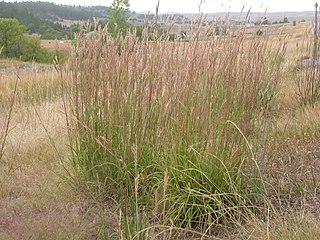
Andropogon gerardi, known commonly as big bluestem, turkeyfoot, tall bluestem, and bluejoint, is a species of tall grass native to much of the Great Plains and grassland regions of central and eastern North America.
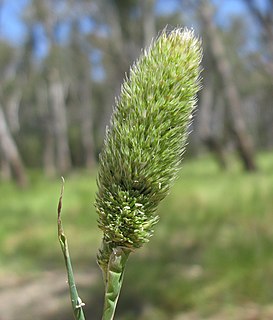
Phalaris paradoxa is a species of grass in genus Phalaris. Common names include awned canary-grass and hood canarygrass.

Sorghastrum nutans, commonly known as either Indiangrass or yellow Indiangrass, is a North American prairie grass found in the central and eastern United States and Canada, especially in the Great Plains and tallgrass prairies.

Sporobolus heterolepis, commonly known as prairie dropseed, is a species of prairie grass native to the tallgrass and mixed grass prairies of central North America from Texas to southern Canada. It is also found further east, to the Atlantic coast of the United States and Canada, but is much less common beyond the Great Plains and is restricted to specialized habitats. It is found in 27 states and four Canadian provinces.

Bromus hordeaceus, the soft brome, is an annual or biennial species of grass in the true grass family (Poaceae). It is also known in North America as bull grass, soft cheat, and soft chess.

Bromus secalinus is a species of bromegrass known as rye brome. The specific epithet secalinus is Latin, meaning "rye-like". The fruits are hard, rounded glumes that appear superficially similar to the rye grain, which gives the brome its common and scientific name. The grass has a diploid number of 28.

Hainardia is a genus of coastal plants in the grass family, native to the Mediterranean Basin.

Bromus madritensis is a species of brome grass known by the common name compact brome. The specific epithet madritensis refers to Madrid, Spain. It has a diploid number of 28.
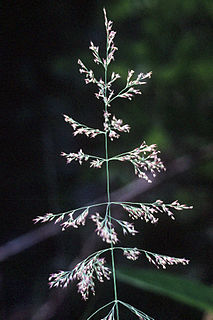
Calamagrostis canadensis is a species of grass, having three or more varieties, in the family Poaceae. It is known variously by the common names of bluejoint, bluejoint reedgrass, marsh reedgrass, Canadian reedgrass, meadow pinegrass, and marsh pinegrass.

Bromus catharticus is a species of brome grass known by the common names rescuegrass, grazing brome, prairie grass, and Schrader's bromegrass. The specific epithet catharticus is Latin, meaning cathartic. The common name rescuegrass refers to the ability of the grass to provide forage after harsh droughts or severe winters. The grass has a diploid number of 42.

Bromus ciliatus is a species of brome grass known by the common name fringed brome. It is native to most of North America, including most of Canada, most of the United States except for some portions of the South, and northern Mexico. It is a plant of many habitats, including temperate coniferous forest. The specific epithet ciliatus is Latin for "ciliate", referring to the delicate hairs of the leaf blades.
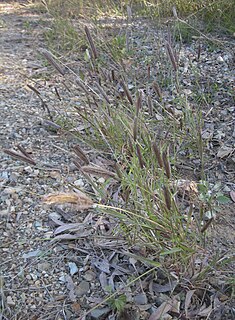
Chloris virgata is a species of grass known by the common names feather fingergrassfeathery Rhodes-grass and feather windmillgrass.
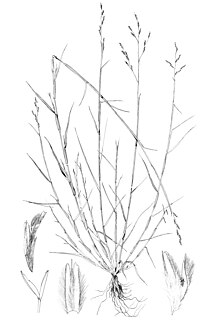
Triplasis is a genus of North American plants in the grass family. Sandgrass is a common name for plants in this genus. The genus name Triplasis is Greek, meaning "threefold", referring to the triple nerved lemmas.

Orcuttia is a genus of grass in the family Poaceae. Plants grow up to 20 cm (8 in) tall, usually with many stems emerging from the base of the plant, and forming a tuft. The spikelets are several-flowered, with reduced upper florets. The lemma tips have between two and five teeth.

Bromus erectus, commonly known as erect brome, upright brome or meadow brome, is a dense, course, tufted perennial grass. It can grow to 120 centimetres (47 in). Like many brome grasses the plant is hairy. The specific epithet erectus is Latin, meaning "erect". The diploid number of the grass is 56.

Muhlenbergia capillaris, commonly known as the hairawn muhly, is a perennial sedge-like plant that grows to be about 30–90 cm (0.98–2.95 ft) tall and 60–90 cm (2.0–3.0 ft) wide. The plant includes a double layer; green, leaf-like structures surround the understory, and purple-pink flowers outgrow them from the bottom up. The plant is a warm-season grass, meaning that leaves begin growth in the summer. During the summer, the leaves stay green, but they morph during the fall to produce a more copper color. The seasonal changes also include the flowers, as they grow out during the fall and stay healthy till the end of autumn. The muhly grows along the border of roads and on plain prairies. The grass clumps into herds, causing bush-like establishments in the area the hairawn muhly inhabits. The flowers are very feathery and add a cloudlike appearance to the top of the grass. It is native to eastern North America and can be used for a multitude of purposes, including ornamental gardening and farming. It was voted 2012 plant of the year by the Garden Club of America.
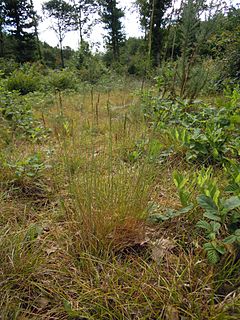
Agrostis vinealis is a species of grass known by the common names brown bentgrass and brown bent, which can be found from Russia to Mongolia, China, Pakistan, India and Alaska. It was introduced to Greenland and South Georgia and the South Sandwich Islands.

Bouteloua simplex, colloquially known as matted grama or mat grama, is a grass species in the grama genus native to much of the Americas.

Glyceria canadensis is a species of grass in the genus Glyceria which is known by the common name rattlesnake mannagrass. It is native to North America, from British Columbia to Newfoundland and south to North Carolina. It is commonly found in wet areas.

Sphenopholis intermedia, the slender wedgegrass or slender wedgescale, is an annual grass native to North America. The specific epithet "intermedia" means "intermediate". The diploid number is 14.




















